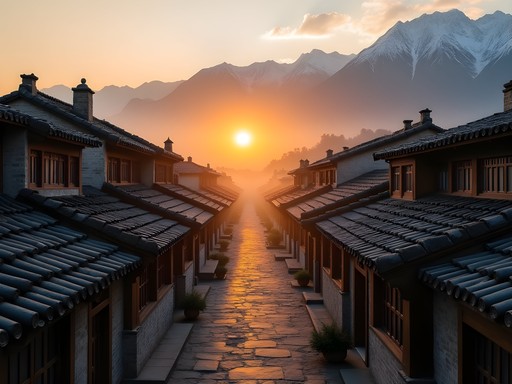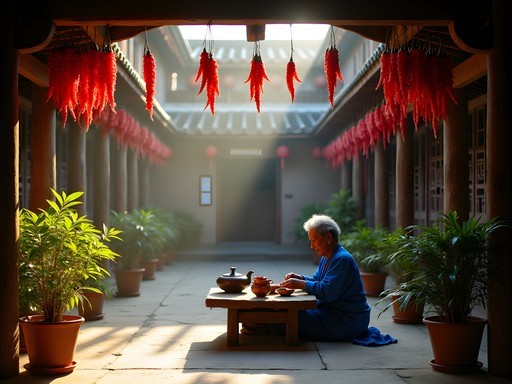Disclosure: This article contains affiliate links. We may earn a commission from purchases at no extra cost to you, which helps our travel content.
The morning mist clung to the ancient rooftops as I wandered through Lijiang's Old Town, the cobblestones still glistening from an overnight shower. Having explored pristine lakes across four continents, I thought I'd seen it all until the emerald waters of Lashi Lake came into view, framed perfectly by the snow-capped Jade Dragon Snow Mountain. Lijiang, nestled in China's southwestern Yunnan province, is that rare destination that seamlessly blends cultural immersion with adrenaline-pumping adventure. This UNESCO World Heritage site offers far more than postcard-perfect scenes—it's a playground for the curious traveler seeking both historical depth and outdoor thrills. After spending a transformative week here last spring, I've crafted this guide to help fellow adventurers navigate this remarkable corner of China, where ancient Naxi traditions meet modern adventure tourism against a backdrop of some of Asia's most breathtaking landscapes.
Navigating Lijiang's Ancient Heart
Lijiang's Old Town (Dayan) isn't just a starting point—it's an adventure in itself. Unlike the meticulously preserved but sometimes sterile historical districts I've encountered in my travels, Dayan pulses with authentic life despite its 800-year history. The labyrinthine network of canals, bridges, and cobblestone streets demands exploration without a map—getting lost here is part of the experience.
My first morning, I rose before dawn to witness the town awakening. Without the daytime crowds, I had the ancient water wheels and meandering canals almost to myself, save for locals preparing for the day. The soft morning light illuminated the traditional Naxi architecture—dark wood frames with intricate carvings supporting whitewashed walls—creating a photographer's paradise.
For cultural context, I spent my second morning at the Mu Family Mansion, once home to the ruling family of the Naxi people. The sprawling complex offers insight into local history that proves invaluable for understanding the region. Later, I wandered to Sifang Street, the central market square, where I practiced my limited Mandarin with vendors selling everything from yak meat jerky to hand-embroidered Naxi textiles.
While Old Town can get crowded with domestic tourists by midday, the early mornings and evenings reveal its true character. I found myself returning each evening to sample local delicacies like crossing-the-bridge noodles and to listen to traditional Naxi music performances that have been preserved for generations.

💡 Pro Tips
- Visit Old Town before 8 AM or after 6 PM to avoid the largest tourist crowds
- Carry cash as many small vendors don't accept foreign cards
- Download a translation app with offline capability—English is limited outside major hotels
Conquering Jade Dragon Snow Mountain
No adventure in Lijiang would be complete without tackling the majestic Jade Dragon Snow Mountain (Yulong Xueshan). Standing at 5,596 meters (18,360 feet), this snow-capped massif dominates the landscape and offers adventures for every fitness level.
After acclimatizing to Lijiang's already considerable altitude (2,400m) for two days, I embarked on my mountain journey. While many tourists take the cable car straight to Glacier Park at 4,506 meters, I opted for the more rewarding Blue Moon Valley trek on the mountain's eastern flank. The 6km trail winds through pine forests before opening to reveal a series of turquoise pools fed by glacial meltwater—a stark, beautiful contrast against the rugged mountain backdrop.
The altitude presents a genuine challenge here. Even as someone who regularly hikes in the UK's Lake District, I found myself pausing frequently to catch my breath. My trekking poles proved invaluable on the steeper sections, providing stability and reducing strain on my knees during the descent.
For those seeking a more immersive experience, I highly recommend the lesser-known Yak Meadow route. This moderate 4-hour hike passes through traditional Naxi and Yi minority villages before reaching alpine meadows where semi-nomadic herders graze their yaks against a backdrop of snow-capped peaks. The authenticity of this experience—far from the cable cars and selfie spots—was the highlight of my mountain adventures.
While on the mountain, don't miss the Impression Lijiang show, an outdoor cultural performance directed by famous Chinese filmmaker Zhang Yimou. Set against the mountain backdrop with hundreds of local performers, it offers valuable cultural context for your adventures.

💡 Pro Tips
- Purchase your mountain access ticket a day in advance to avoid morning queues
- Start hikes early to avoid afternoon thunderstorms common in spring
- Altitude sickness is real—stay hydrated and consider a local herbal remedy called 'hong jing tian'
Tiger Leaping Gorge: China's Epic Trek
While technically just outside Lijiang, Tiger Leaping Gorge deserves its reputation as one of the world's great treks. This 16km-long canyon, where the mighty Jinsha River (upper Yangtze) squeezes between Jade Dragon and Haba Snow Mountains, offers a two-day hiking adventure I'll never forget.
The classic high trail spans 22km from Qiaotou to Tina's Guesthouse, with most hikers spending one night at the midpoint. What makes this trek special isn't just the dramatic scenery—though watching the river rage 2,000 meters below as you traverse narrow paths cut into near-vertical cliffs is certainly memorable. It's the cultural immersion that elevated my experience, staying in family-run guesthouses where I shared meals with Naxi families and fellow travelers from across the globe.
The trek's most famous section, the 28 Bends, is a steep zigzagging ascent that tests your endurance but rewards with increasingly spectacular views. My hiking daypack proved perfect for this adventure—lightweight yet spacious enough for water, snacks, rain gear, and my camera equipment.
I opted to hike independently rather than with a guide, which I'd recommend for experienced hikers comfortable with navigation. The trail is generally well-marked, though a few confusing junctions benefit from the detailed maps available in Lijiang's guesthouses. For those preferring guidance, several Lijiang-based outfitters offer guided treks with English-speaking guides who provide cultural context that enriches the journey.
One night wasn't enough for me—I extended my stay at Halfway Guesthouse, spending a full day exploring side trails to waterfalls and Naxi villages before continuing onward. The sunset from their terrace, with golden light illuminating the gorge while we sipped local barley wine, remains one of my most treasured travel memories.

💡 Pro Tips
- Book guesthouses in advance during peak spring season (April-May)
- The trail can become dangerous during heavy rain—check weather forecasts
- Carry at least 2 liters of water per person for the first day's hike
Cultural Immersion Through Naxi Traditions
What separates a tourist from a traveler is often the depth of cultural engagement. In Lijiang, the indigenous Naxi culture offers abundant opportunities for meaningful connection that complement the region's physical adventures.
The Dongba Cultural Museum provided my foundation for understanding Naxi heritage, particularly their unique pictographic writing system—the world's only living hieroglyphic language still in use today. While the museum offers excellent English translations, I gained deeper insight by arranging a private session with a Dongba priest (spiritual practitioner) through my guesthouse. For two hours, he demonstrated traditional paper-making techniques and taught me to write several Dongba characters representing natural elements.
Food offers another window into culture. Rather than sticking to Old Town restaurants with English menus, I ventured to Zhongyi Market where locals shop. Here, I joined a small cooking class where a Naxi grandmother taught us to prepare baba (flatbread) and rushan (local cheese) using traditional methods. These hands-on experiences connected me to local life in ways impossible through observation alone.
Perhaps my most memorable cultural experience came through music. The Naxi Orchestra performs ancient Han and Tang dynasty music preserved in Lijiang when it disappeared elsewhere in China. Before attending a concert, I invested in a quality digital audio recorder to capture these rare melodies (with permission). These recordings, along with my journal entries, transport me back to Lijiang more vividly than photographs.
For those interested in traditional crafts, I recommend visiting Baisha Village, just 10km from Lijiang. Here, the ancient art of Baisha embroidery continues in small workshops where master artisans create intricate pieces using techniques passed down for generations. Many offer short demonstrations or multi-day workshops for visitors truly committed to learning.

💡 Pro Tips
- Learn a few basic Naxi greetings—locals genuinely appreciate the effort
- Ask permission before photographing people, especially elders in traditional dress
- Support authentic cultural preservation by purchasing directly from artisans rather than souvenir shops
Beyond Lijiang: Day Trips to Hidden Gems
While Lijiang itself offers enough to fill a week, the surrounding countryside reveals even more adventure opportunities. With a rental bicycle or local driver, several remarkable destinations await within easy day-trip distance.
Shuhe Ancient Town, just 4km north of Lijiang, offers a glimpse of what Lijiang might have been like before mass tourism. As a former stop on the ancient Tea Horse Road (a trade route comparable to the Silk Road), Shuhe maintains its historical character while feeling less commercialized. I spent a peaceful afternoon here, wandering quiet lanes and visiting the Mu Family's summer residence.
For nature enthusiasts, Lashi Lake provides a serene counterpoint to mountain adventures. I arranged a morning birdwatching excursion through my guesthouse, using my compact binoculars to spot several migratory species including the black-necked crane. Local fishermen still practice traditional methods here using trained cormorants—an ancient fishing technique rarely seen elsewhere.
Perhaps the most rewarding day trip was to Wenhai Village, a traditional settlement perched at 3,100 meters on Jade Dragon Snow Mountain's western slope. Accessible only by a 3-hour hike or rough jeep track, this remote village offers authentic homestay experiences with Naxi families. I arranged my visit through a community-based tourism initiative that ensures tourism benefits flow directly to local families. My host family shared traditional meals, taught me about their sustainable farming practices, and guided me on hikes to alpine meadows where few tourists venture.
For those interested in Buddhist culture, Fuguo Monastery sits just 5km from Old Town. Founded in 1596 during the Ming Dynasty, this active monastery houses a 500-year-old camellia tree that blooms spectacularly each spring. The resident monks welcomed me to observe their afternoon chanting ceremony—a profound experience that highlighted the region's religious diversity alongside the indigenous Dongba faith.

💡 Pro Tips
- Arrange transportation the day before for early morning departures to beat crowds at popular sites
- Bring extra layers for high-elevation destinations like Wenhai where temperatures drop significantly
- Consider hiring a local guide for remote villages—they facilitate meaningful interactions impossible to arrange independently
Final Thoughts
As my week in Lijiang drew to a close, I found myself already planning a return visit. This remarkable corner of Yunnan offers that perfect balance I'm always seeking—authentic cultural experiences alongside genuine adventure, all set against a backdrop of staggering natural beauty. What makes Lijiang special isn't just its UNESCO-protected architecture or towering mountains, but the way traditional life continues amidst it all. The Naxi people have adapted to tourism while maintaining their cultural integrity, offering visitors like us a chance to connect with traditions that stretch back centuries. Whether you're summiting mountain trails, learning ancient pictographs, or simply wandering cobblestone lanes at dawn, Lijiang rewards the curious traveler willing to venture beyond the obvious. Pack your hiking boots, an open mind, and perhaps most importantly, patience—the real magic of Lijiang reveals itself slowly to those willing to look beyond the surface.
✨ Key Takeaways
- Balance your time between Old Town exploration and mountain adventures for the full Lijiang experience
- Rise early to experience ancient streets before crowds arrive and to maximize hiking time in spring
- Seek authentic cultural experiences through local guides and community-based tourism initiatives
- Allow time for acclimatization before attempting higher elevation activities
📋 Practical Information
Best Time to Visit
Mid-March to early May for comfortable temperatures and spring blooms
Budget Estimate
$50-100 USD per day including mid-range accommodation, meals, and activities
Recommended Duration
7-10 days minimum to include Tiger Leaping Gorge trek
Difficulty Level
Moderate (Altitude Considerations And Some Challenging Hikes)
















Comments
AsiaFan42
Your photos of Jade Dragon Snow Mountain are incredible! Added to my bucket list!
wildking
Great post! Planning to visit Lijiang in November. Is that a good time? Also curious about getting around - did you find it easy without speaking Chinese?
Timothy Jenkins
November can be chilly but clear - perfect for hiking! The town gets quieter which is nice. Language was tricky in spots, but I used a translation app with downloadable Chinese dictionary that worked offline. Most guesthouses in Old Town had some English-speaking staff. Buses were the hardest part - have destinations written in Chinese characters!
wildking
Thanks for the tips! Will definitely download that app before going.
Hunter Thompson
Brilliant write-up, Timothy! I did Tiger Leaping Gorge last year and it absolutely blew my mind. Your description of that 28 bends section gave me flashbacks - I was practically crawling by the end of it! 😂 Did you stay at the Halfway House? Their terrace view at sunset is unreal. One tip for anyone heading there: the weather can change super quickly, so layers are essential. I'd add that spring (April-May) is actually my favorite time for Lijiang - fewer tourists and the wildflowers around the gorge are incredible.
Timothy Jenkins
Thanks Hunter! Yes, I did stay at the Halfway House - that terrace view with a beer in hand was the perfect reward after those brutal 28 bends! Great tip about spring visits too.
wildking
How difficult is the Tiger Leaping Gorge trek really? I'm reasonably fit but not a hardcore hiker. Worth attempting?
Hunter Thompson
Hey wildking! If you're reasonably fit you'll be fine. The 28 bends section is tough but short (about 1-2 hours). Take it slow, plenty of water, and you'll make it! The views are 100% worth the effort. I saw 70-year-olds doing it!
redace
Great guide! One quick tip for photographers: the light on the old town is magical about 30 minutes before sunset, especially from Black Dragon Pool Park. Worth timing your visit there accordingly.
Lillian Diaz
I spent three weeks in Yunnan last year and Lijiang was definitely a highlight! For anyone planning to go, I'd recommend spending at least 3 days in the Old Town area to really soak it in. The morning light there is magical for photography, especially before the day tourists arrive. One thing I'd add to Timothy's excellent guide - check out Baisha Village just outside Lijiang proper. It's less touristy and has incredible ancient murals. I hiked there from Old Town (about 2 hours) and used my hiking poles which were super helpful on the uneven paths. Also, for anyone doing Tiger Leaping Gorge, the guesthouse called Halfway House has THE best view from their terrace. Their apple pie is legendary among hikers too!
sunsetstar
Yes to Halfway House! That terrace view with a beer after a long day hiking was one of my favorite China memories.
starking
Thanks for the Baisha Village tip! Adding it to my list.
Bryce Diaz
Timothy, your post brought back so many memories! I spent a month in Yunnan last year and Lijiang was definitely a highlight. For anyone planning a visit, I'd add that spending time with the Naxi people was the most rewarding part of my stay. I was lucky enough to participate in a traditional music performance in one of the courtyards off the main streets - much less touristy than the big shows. One tip for getting around: the local green minibuses are incredibly efficient for reaching nearby villages like Baisha and Shuhe. Just 2 yuan and they run every 10 minutes from the north gate. The drivers don't speak English but if you show them the Chinese characters for your destination, they'll signal when to get off. Also, did you try the local specialty 'baba' flatbread? The one with rose jam filling was my daily breakfast!
Timothy Jenkins
Thanks Bryce! Yes, those green minibuses are a hidden gem for budget travelers. And the rose jam baba - absolutely delicious! I became addicted to the yak milk tea as well.
smartbackpacker6319
Just added Lijiang to my China itinerary after reading this!
photozone
Great post! Did you have any issues with altitude sickness on Jade Dragon Snow Mountain? I'm heading there next month and wondering if I should take some precautions.
Timothy Jenkins
Thanks for asking! Yes, the altitude is definitely something to prepare for. I spent 3 days in Lijiang (2400m) before attempting the mountain. Still felt the altitude at the upper cable car station (4500m). I'd recommend bringing some altitude sickness pills, staying hydrated, and taking it slow. The views are worth it though!
photozone
Perfect, thanks for the advice! I'll make sure to acclimatize properly and pack my altitude sickness pills just in case.
bluelife
Those ancient rooftops in the mist look magical! Added to my bucket list!
journeyclimber
Wow, your photos of Tiger Leaping Gorge are absolutely stunning! I've been dreaming about hiking there for years. How difficult was the trek really? I'm reasonably fit but not exactly a mountaineer. Did you do the high trail or the low road? And how many days would you recommend setting aside for it? Planning my first China trip for next spring and Lijiang is definitely on the list!
redace
Not OP but I did the high trail in 2 days last year. Moderate difficulty but worth every step. Day 1 is the toughest with the 28 bends section.
journeyclimber
Thanks redace! How were the guesthouses along the way?
redace
Basic but charming. Naxi Family Guesthouse had amazing views. Bring cash though!
Venture X
Premium card with 2X miles, $300 travel credit, Priority Pass